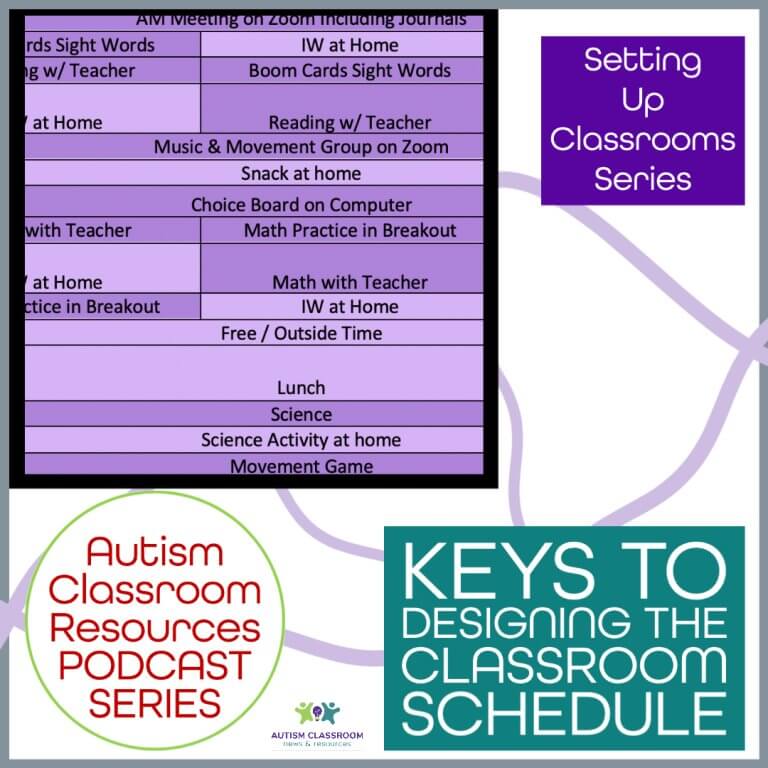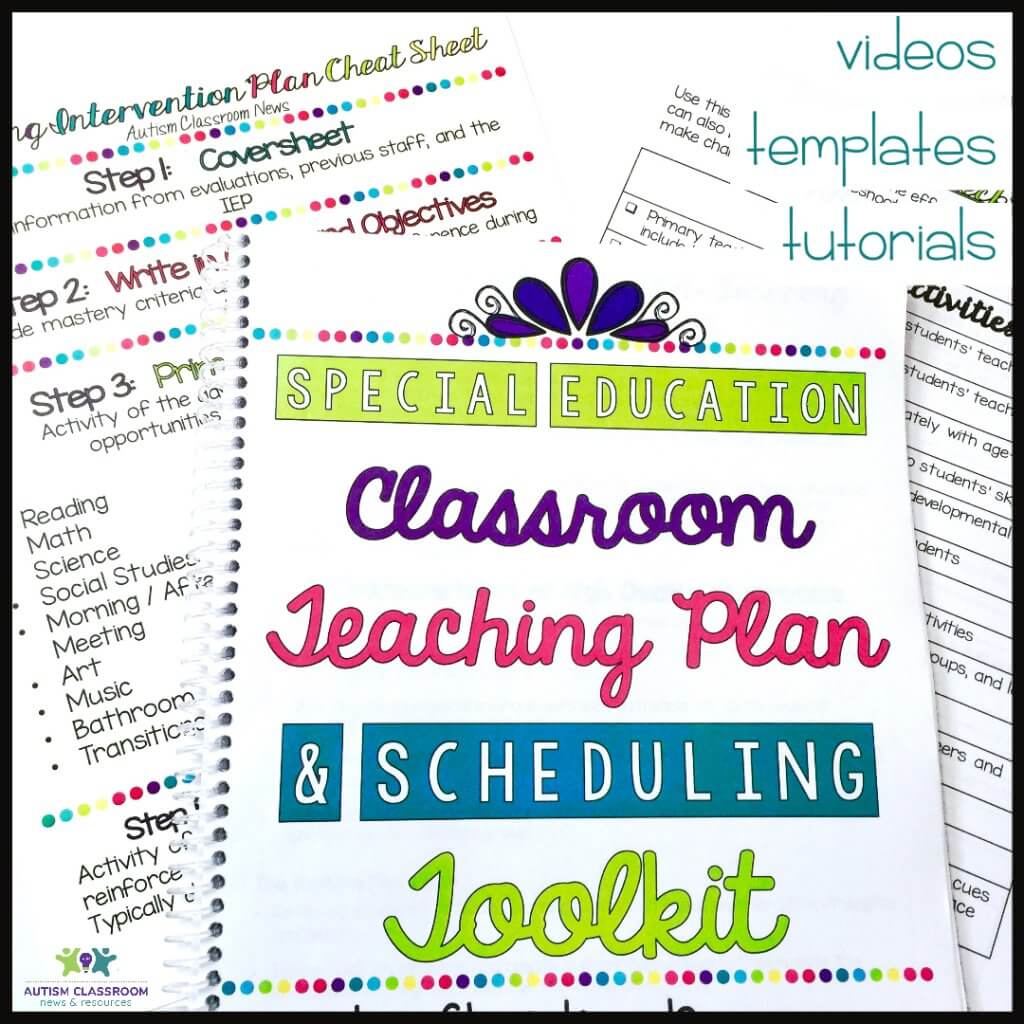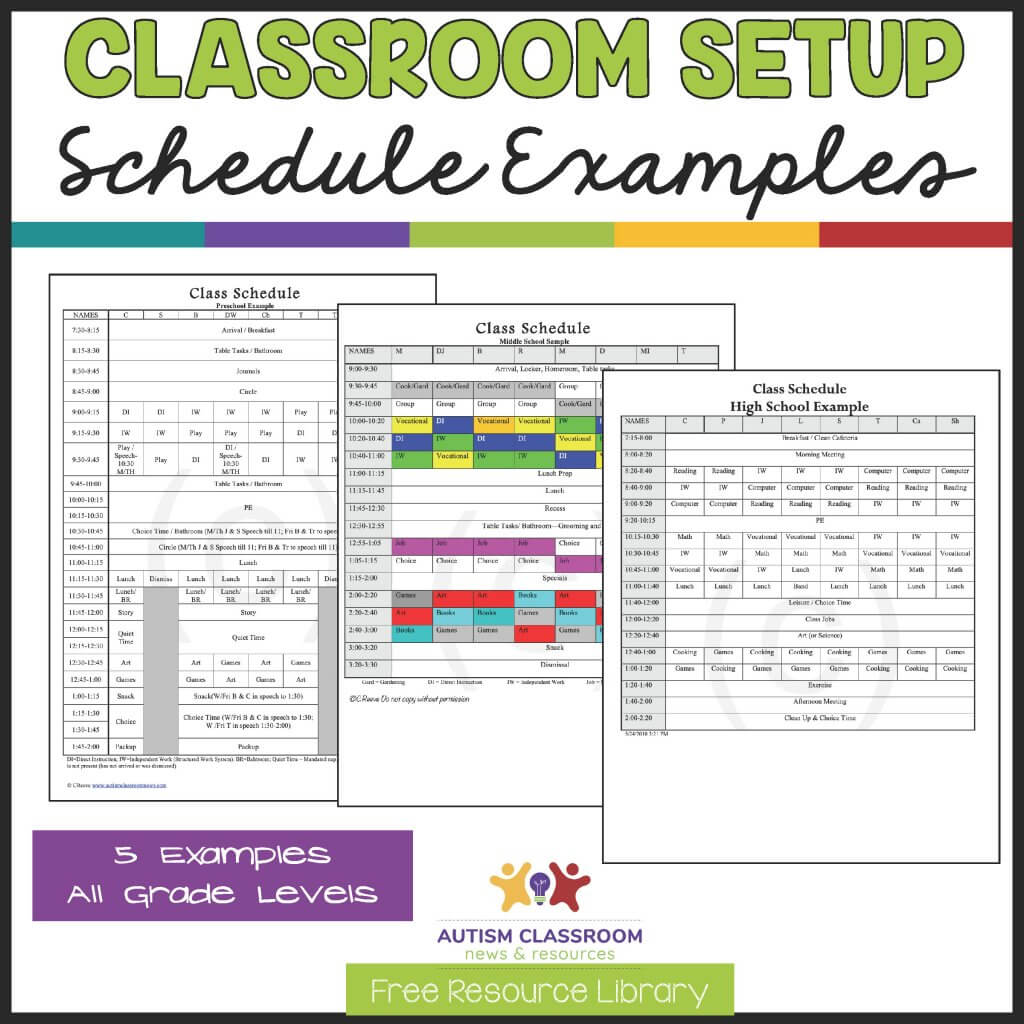The Challenges of Creating the Schedule
One year I was setting up one of the toughest classroom schedules I had ever created. I had 12 students in a self-contained classroom who ranged in ability from not being able to stay in their chair to being pretty independent but badly needing to learn social interaction skills. There were also either 8 or 9 staff. (It kills me that I can’t find a copy of this schedule 😩).
Anyway, it was a tough schedule when I sat down to try to figure out how I would group the students together. You see we had 8 or 9 staff, but only 3 or 4 of them were regularly in the room because almost every student went to general education with a staff member.
There were lots of challenges with this schedule, but the one that sticks in my mind most was how to group these students. You see, when I go to create a schedule, the students typically rotate through a set of centers in groups. There are lots of ways that you can group students. But in this classroom, while I knew it would be tough, I grouped 3 of the more independent students together to work on social interaction throughout their centers. And that meant that 2 students who had some significant challenging behavior and didn’t typically remain in an area would be together.
I thought my team was going to KILL me by the end of the first day. Because all the person running that group of 2 students did was manage behavior and run after the students.
Brainstorming the Solution
So, my team and I hashed this around and around after the first day of school. They begged me to change the schedule. I explained why I grouped the students as I did. We all recognized the importance of the students in need of socialization having that opportunity. However, it took us a while to come to a conclusion about what to do about the schedule.
We finally decided that we didn’t want to break up the groups that we had. And that left us with figuring out how to make it work for the two students who had limited learning readiness skills. So, we made a decision to change the environment.
Solution
We rearranged the environment so that the students had furniture giving them boundaries of where to stay in the center. That afternoon, we made a ton of simple, 1-step work tasks that the two student could engage in easily with limited support. And when we had an extra set of hands, we zoned them to that area during center time. Then we worked hard to concentrate on teaching basic learning readiness skills like sitting in the chair and following directions. It wasn’t an easy schedule but after a few days, it got easier. The key was always making sure that the students had something in their hands to do.
On to the Present Day
As we approach the beginning of 2020, and grapple with how to best educate students during the pandemic, setting up the special ed classroom schedule may seem like the least of our problems. In reality, though, it’s still the most important. Whether you are doing distance learning or social distant classroom learning, the schedule continues to drive the predictability and routine our special ed classrooms need. It’s also one of the most complex parts of setting up a special ed classroom.
In Episode 41 of the podcast, I talked about the model for classroom setup focusing on meeting the individual needs of the students. And the importance of routine and predictability for our students. In Episode 42, I talked about how to begin that individualization with the Teaching Implementation Plan. This week, we are going to take the TIP information and start to translate it into the schedule.
Selecting Activities
Once you have your TIPs completed for all the students, you should have some idea of what activities you are going to include in your schedule. Because of the time we are living in, the activities may look a little different than the way we have done it before.
Regardless of your setting, there are a few things you want to make sure you have in place.
- You want to make sure you have a mix of activities by size of groups. So you want some small and full-class groups. What those look like will depend upon the students.
- You also want to make sure you have a mix of physical and sedentary activities. I think this is going to be incredibly important regardless of your setting. If you are doing distance learning, you may want to make sure you have some movement scheduled frequently. It’s going to be important to counterbalance the screen staring. If you are doing classroom instruction, students are probably going to need to stay in the same space during the day. That’s going to make movement breaks even more key.
- Don’t forget you always want your classroom activities to be age-respectful. Younger activities for younger children. Developmentally appropriate but older-looking activities for our middle and high school students who have significant disabilities.
- And finally, it’s important that we are building a classroom by selecting activities in which we can embed the student’s goals and curriculum. I’m not a big fan of classrooms of all 1-1. But all full group won’t make much sense in most of our classrooms either. Like most of our decisions in special ed classroom setup, it depends on the students.
Distance Learning Activities in the Special Ed Classroom Schedule
Distance learning activities might include a variety of online and off-line activities. Remember that students doing distance learning still need to practice skills they have learned. And they still need explicit instruction from the teacher. So you want to strike a balance of those two to accommodate their family schedule and your schedule. To address this, you might send an independent work system home with video models (like we have in the Special Educator Academy) of how to set it up and use it.
Socially Distant Activities in the Special Ed Classroom Schedule
If you are teaching in the classroom but following social distancing rules, you might want to use centers. If you can’t rotate students to different groups, switch it up. Leave the students in their places in groups and rotate the staff. This limits their exposure to other students but still allows them to work with different adults. And don’t forget you may want to add some socialization activities in. Even though you are being socially distant, you can work on games and activities that involve the small or large groups for social skills.
Allocating Time in the Special Ed Classroom Schedule
Once you know what your activities will be, it’s a matter of deciding how long they should be. In some classes, you might have a 5-minute morning meeting. In others, it might be 25 minutes. It depends on the needs of the students. Here are some keys to allocating time for schedules, regardless of setting.
- Always have activities end with success. If students are tuning out or leaving the activity before it’s over, it’s too long. Better to start with shorter times and then make them longer. Having a schedule that moves too quickly is easier to fix than trying to reign in the problems created by activities that are too long.
- Your times may need to match up to the school schedule or bell schedule. Don’t get yourself caught in the trap of thinking you have to do one activity for 90 minutes. This is particularly the case with older grades. However, that does not mean you have to do the same activity the whole time. Break it up into smaller chunks. The general ed. teachers do this too…they just call it all by the subject being taught.
- It’s OK for students to participate in different times for an activity. Jamal may be able to manage group activity for 10 minutes. Carlos may need 20 minutes to make it worthwhile. Just make sure that when Jamal is finished, you have something for him to do. He can’t just sit and wait-he needs instructional time. He just needs it in smaller chunks.
Grouping Students in the Special Ed Classroom Schedule
This goes back to the anecdote I shared at the beginning of the podcast. And it might be one of the trickiest pieces of putting it together. You can group student who are similar or different across activities. Sometimes it might make sense to group students so that you have an independent worker with a student who needs more assistance. Or it might make sense to put students with similar social skills needs together. You might also put those more socially adept students in groups with students who benefit from social models. This provides the model, but it also helps increase the confidence of the model himself.
It’s often assumed you should place students with similar academic needs in the same groups. For academic centers this can be helpful to reduce the amount of switching of activities for the instructor. But you don’t have to do it this way. You can have students working on their assignment while you instruct a student on a different level. And then switch. The more you practice it, the easier it is to do and assure you are attending to both students at the same time and equally.
Sequencing Events in the Schedule
Once you have an idea of the activities and the length, as well as the student groupings, you can start to think about how to sequence the activities. This is an area that I think is going to be tough in the coming year. If you are sequencing activities in the classroom typically, I use the First-Then (Premack) Principle for students who are having the most difficulty. So they have an activity with challenging instruction, followed by independent work where they are confident they can complete it. Then we might come back to more challenging new material.
The challenge I think we are going to have in the fall of 2020 is that in the classroom, you may not be able to move the students around. We can solve that by rotating the staff to do a center rotation. But you may not be able to change up the groups for different types of activities. So that is more of a challenge.
For distance learning, especially if you have a paraprofessional(s), you can still do centers online. If your students are doing face-to-face with web conferencing like Zoom, use breakout rooms. Breakout rooms allow you to divide the class into smaller groups where they could work with a paraprofessional. You can also consider having the students do a center, like independent work, at home. They can leave the web conference open and complete a hands-on work system or do a rotation with their parent practicing skills with them. That allows you to sequence the activities with active and passive activities as well as challenging and practice work mixed together.
Putting It All Together
When it comes to putting all these pieces together, I use a schedule grid broken down into different time periods (e.g., segments of 10 to 30 minutes depending on the situation). I start with the activities I cannot change. So if lunch, recess and PE are scheduled out of my control, those go in first.
Then I prioritize whose schedule in the classroom needs to be most finessed. Which students need to have challenging work followed by independent work. I sometimes call this “in my face” work and “leave me alone work.” These are the students who can’t handle too much challenging work all at one time. They are the most sensitive to the sequencing of the activities. So I schedule them first. The other students can handle a few more challenges at a time, so it’s easier to schedule around students who need more finesse in their schedule.
And as you put your schedule together, you want to make sure that each activity on the schedule has specific goals for why you are doing it. And you want to be sure that you have activities scheduled throughout the day.
Looking for What a Schedule Might Look Like?
Head over to the Free Resource Library where I’ve got 5 example classroom schedule grids from different ages you can download and check out.
Tips for Setting Up the Schedule
I know sometimes it’s tempting to schedule time in time between transitions, but I assure you that in a special education classroom schedule, downtime is not your friend.
Schedules Will Always Have to be Tweaked
And when all of this is done, you then run the schedule and see how it works. You’ll most likely have to tweak it when you try it, which is to be expected. I’ve never had a schedule work perfectly the first time. But if you have thought it through at the beginning, there will be fewer changes while you are trying to run the classroom.
Class Schedules Don’t Run Like Trains
Keep in mind that the schedule doesn’t have to run like a train. The times you are putting on it are approximate. Check with your staff (or family if it’s distance learning) to find out if they are ready to make a transition. I like to designate a person as the timer. That person has a timer and sets it for a few minutes before the end of the activity. Then, when it goes off, they check with the staff. If the person running art needs just an extra minute, then the other staff know to stretch their activity out. If the person running another activity is having a horrible time keeping students engaged, then maybe you transition a little sooner.
Setting up the special ed classroom schedule is probably the most challenging part of starting the new school year. However, if you put the time in up front, I guarantee it pays off in less stress at the start of the year.
This year may be even more challenging depending on your situation. In the Special Educator Academy we are working through it together. We have training on restarting school, on setting up distance learning, and we’re adapting the Setting Up Classrooms course in a study group to meet the needs of all the different classroom configurations going on this year. So hop over and join us...we can help.











